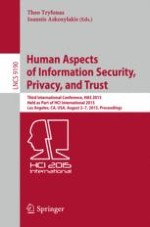2015 | OriginalPaper | Buchkapitel
From V2X to Control2Trust
Why Trust and Control Are Major Attributes in Vehicle2X Technologies
verfasst von : Teresa Schmidt, Ralf Philipsen, Martina Ziefle
Erschienen in: Human Aspects of Information Security, Privacy, and Trust
Aktivieren Sie unsere intelligente Suche, um passende Fachinhalte oder Patente zu finden.
Wählen Sie Textabschnitte aus um mit Künstlicher Intelligenz passenden Patente zu finden. powered by
Markieren Sie Textabschnitte, um KI-gestützt weitere passende Inhalte zu finden. powered by
